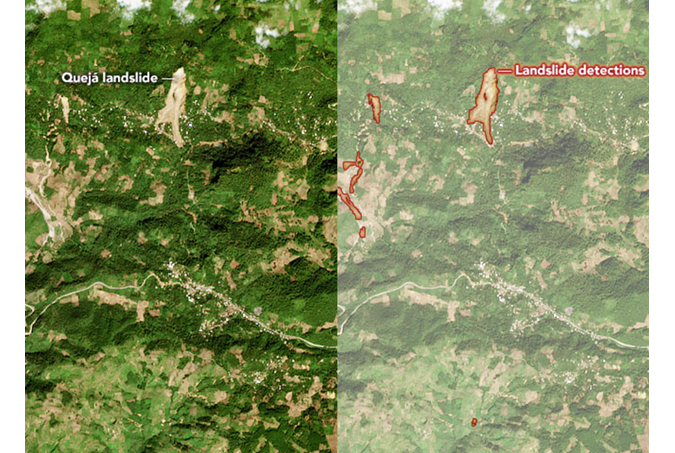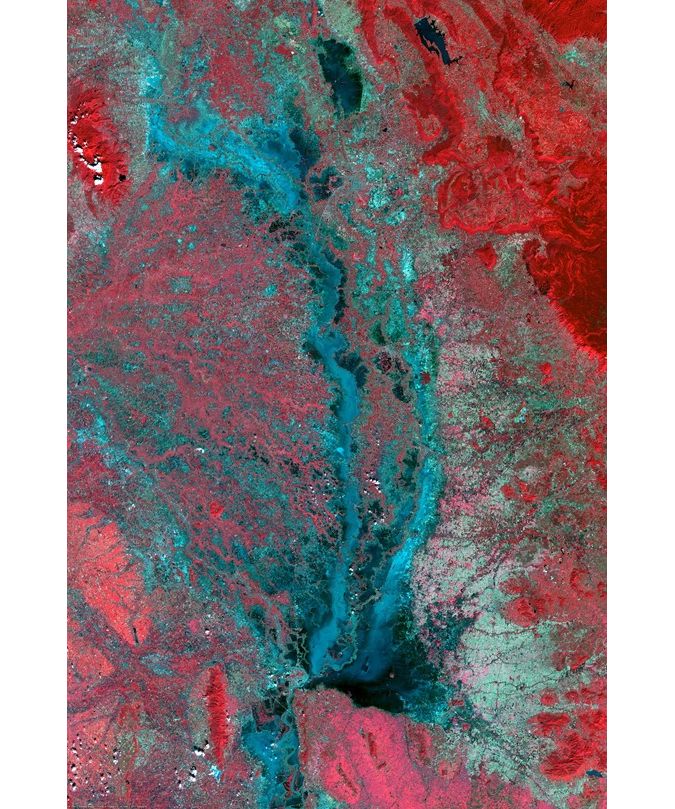wi Geo4Dev倡议旨在结合起来研究th geospatial data to support global development in line withthe 2030 Agenda for Sustainable Development。作为结束贫困并为所有人在健康星球上的和平,繁荣与机遇的道路上的目标的一部分,2030年议程认识到基于太空技术的数据的重要性,原位监测和可靠的地理空间信息可持续发展,政策制定,编程和项目运营。Geo4Devis a collaboration between academia, public and the private sector that integrates rigorous research with innovative sources of geospatial data, including satellites, sensors and mobile phones, together with artificial intelligence, machine learning and computer vision approaches.
This blog is contributed by跑了戈德布拉特,,,,Trevor Monroe,,,,Maria Jones,,,,道格拉斯·格兰登(Douglas Glandon),,,,塞缪尔·菲什曼(Samuel Fishman),,,,Daynan Crull,,,,Gabe LevinandGhermay Araya。
Our world is changing
Our world is rapidly changing in almost every dimension. In 2007, for the first time in history, the global urban population exceeded the global rural population and by 2050 nearly 70% of the world's population will live in urban areas.
While there is no doubt that urbanization has many positive implications for society, economy, welfare and more, this does not come without immense challenges. Rapid urbanization may damage ecosystems, increase emission of gases, increase demand for public services, put pressure on public infrastructure and may increase the gap between rich and poor. Urban areas were also the most vulnerable to the recent COVID-19 pandemic, and the majority of global COVID-19 cases are reported in urban areas.
With slower investments in infrastructure, housing and other basic services, more people are living in slums, and in parallel, poverty and extreme poverty are also rising. In 2018, almost 8 per cent of the world’s workers and their families lived on less than US$1.90 per person per day, and COVID-19 may push between 88 and 115 million people into extreme poverty (Poverty and Shared Prosperity Report 2020)。

In parallel, since the 1940`s, there has been an increase in the frequency and severity of global natural disasters. Extreme weather and floods account for the majority of global natural disasters with immense impacts to vulnerable populations in low-income countries.
粮食安全是许多发展中国家面临的另一个挑战。与气候变化,冲突和传染病有关的冲击正在损害粮食生产,破坏供应链并限制负担得起的食物的可及性。根据FAO的数据,将近6.9亿人(占全球人口的8.9%)经历了饥饿感,五年来增长了近6000万。
Yet, accurate data on the number of poor people, their living conditions and vulnerability are scarce, especially in developing countries. Census counts and population surveys comprise the primary sources of this type of data, but these are published infrequently, varying in resolution and precision, due in part to limited available resources for data collection. On the other hand, innovative sources of data facilitate the development of new approaches for demographic modeling and measurement of wealth.
用于开发的地理空间数据
And indeed, everything in our world has a spatial dimension. Poverty and other societal characteristics, social justice disparities, economic trends, food security, changes to ecosystems and aspects related to society well-being or inequality hold physical dimensions.
Integrated geospatial measurement capabilities enable an ever-increasing capability for granular measurement development and finer evaluation methods. Ground and remote sensors measure and collect climatological and environmental data, such as the quality of water, air and soil; mobile phones and GPS devices collect data on movement of people; cameras constantly monitor the functionality of critical infrastructure; sensors on board satellites, airborne and UAVs capture almost every location on Earth - monitoring economic activity and agriculture land productivity; stream gauges help track the impacts of floods on vulnerable populations; Volunteered Geographic Information is collected and contributed by volunteers, complementing (or replacing) traditional data sources; while geodata is used to support disaster management operations. Satellite data is being used today to measure the economic and societal impacts of COVID-19, for example, by looking at changes in nighttime light emissions.

Publicly available remotely sensed data are collected, for example, by sensors on board Landsat or Sentinel satellites at a spatial resolution of up to 10m and used to understand socio-economic dynamic in every location on Earth, while nighttime light data collected since the 1990s are leveraged to map poverty or estimate the distribution of populations and economic activity.
GEO4DEV倡议
随着如此多样化的数据的越来越多,正在开发并为传统上不依赖或知道如何理解地理空间数据的部门提供新的工具和方法。同时,在使用地理空间数据,应用和工具的使用基础培训方面,要付出了很多努力,以促进更可持续的环境和社会。
And this is exactly the objective of The Geospatial Analysis for Development (Geo4Dev)倡议。Geo4Dev旨在推动发展t of new data, tools and methods for conducting geospatial analysis across diverse sectors, including agriculture and food security, urbanization, climate change, impact evaluation, humanitarian crisis, and disaster response. It brings together a network of leading researchers, government ministries, NGOs, private enterprises, and funding partners to inspire and support new research collaborations, share knowledge, and build capacity to utilize geospatial data, tools, and approaches.

On 10-11 December 2020, the Geo4Dev Initiativehosted在线研讨会和研讨会,以展示地理空间数据的最先进工具,数据集和应用全球开发研究的应用,然后为那些有兴趣在该领域建立或磨练自己的技能的人举办动手研讨会。召集还正式启动了新的GEO4DEV网站 - 用于地理空间数据和研究的开放式枢纽。第二天还展示了几个夜间灯光数据集,该数据集旨在供代理商(NOAA),世界银行和科罗拉多州矿业学院(NOAA),包括国家海洋和大气管理局(NOAA)公共使用。
这event showcased a wide range of applications of nighttime light data in development research and operations, including the use of big geodata for impact evaluation, prediction and inference of wealth, income and population with satellite data, measurement of the economic impacts of COVID-19 with nighttime lights and more.克里斯·埃尔维奇(Chris Elvidge)博士,,,,who delivered the keynote, provided an overview of the DMSP and VIIRS low light imaging datasets and the new annual VIIRS nighttime series. The second day of the symposium provided a series of hands-on training on how to interpret, process, visualize and analyze this vast amount of raw nighttime light imagery and convert it into meaningful information that can help answer policy questions.
Other speakers illuminated a range of applications for nighttime light data, in particular in the transport sector.Théo Bougnaand爱丽丝·杜哈特(Alice Duhaut)of the World Bank’s角钱分析小组presented on uses of nighttime light data to measure the impacts of road and transport corridor projects that include changes in economic activity, income, and urbanization. Their research demonstrated the possibility of using satellite imagery to develop fast approaches to delivering policy relevant information about impacts in data scarce and conflict-affected regions.

一组扬声器还提出了新的方法,用于使用卫星图像和预测建模来将方法转化为贫困度量和缓解。Gordon Hanson,,,,Marshall Burke,,,,and约书亚·布鲁门斯托克(Joshua Blumenstock)all discussed machine learning approaches using satellite imagery to predict socio-economic and demographic characteristics and/or changes at disaggregated levels.
And in a world dominated by COVID,Mark Robertsof the World Bank’s Urban, Resilience and Land Global Practice, showed how nighttime lights in Morocco could be used to trace real-time GDP at the national and sub-national level, and in turn track economic impacts of the pandemic.
Also featured in the Geo4Dev symposium and workshop was a forthcoming World Bank data set called “Light Every Night” via the AWS Open Data program, which is the culmination of a several year collaboration between the World Bank, NOAA, and the University of Michigan. The data set comprises the DMSP and VIIRS data catalog published asAnalysis Ready Data(ARD)根据世界银行的开放数据许可。在一个地方,夜间灯光的每日测量将近30年,将是对各种政策和研究应用程序的见解的基础。来自世界银行和ARD社区的开源教程和工具将帮助发展社区将数据转变为可持续发展的宝贵见解。
Video recordings of both the symposium and workshop can be foundhere。这tutorials presented during the second day of the event can be foundhere。
Summary
Geo4Dev aims to provide a hub that inspires and supports new research collaborations, share knowledge, and build capacity to utilize geospatial data, tools, and approaches to measure all aspects of developing countries. There is an increasing interest in the use of geospatial data to measure development aspects.遥感Journal has recently launched two Spatial Issues related to the use of geospatial data for development which are now open for submission of papers and communications:遥感测量值,以监视实现可持续发展目标(SDGS)的实现and遥感of Night-Time Light。发展工程journal accepts papers for submission to a Spatial Issue in the field of Geospatial Analysis for Development.
About Geo4Dev
这地理空间分析(GEO4DEV)主管由Center for Effective Global Action (CEGA),,,,新的轻型技术(NLT), and the国际影响评估倡议(3IE),并促进了地理空间数据的使用,用于对社会和经济发展计划的定位,设计和评估,尤其是在低收入和中等收入国家。该计划推动了进行地理空间分析的新数据,工具和方法的开发和采用,同时支持其在包括农业和粮食安全,城市化,气候变化,影响评估,人道主义危机和灾难反应在内的各个部门的应用。


